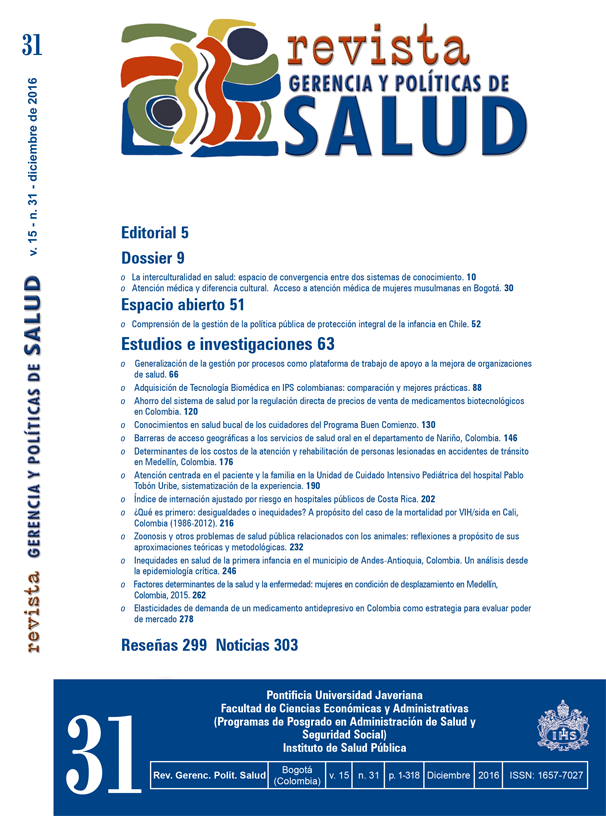Abstract
A prolonged hospitalization constitutes an important hospital management problem. The purpose of this study is to calculate an index which identifies the hospitals with an inadequate hospitalization management. The hospitalization adequacy index is calculated by dividing the observed hospitalizations by the expected hospitalizations in each hospital. The latter are calculated with a regression model which takes into account the socio-demographic and clinical characteristics of the patients. We use the basis of hospitalization discharges of the public healthcare system in Costa Rica for 2014. 43% of the hospitals have an inadequate hospitalization management, as they record more hospitalization days than expected according to the corresponding case load. We conclude that the clinical-management information of the Costa Rican public healthcare allows us to estimate a hospitalization adequacy index as to identify hospitals with an inadequate hospitalization management.
en: http://dx.doi. org/10.11144/Javeriana. rgyps13-27.dehm
2. Tamargo T, Jiménez R. El ajuste por riesgo en la evaluación del desempeño hospitalario. Rev Cubana Salud Pública. 2009; 35.
3. Martín J, López MP. La medida de la eficiencia en las organizaciones sanitarias. Presupuesto y Gasto Público. 2007; 49:139-61.
4. Copnell B, Hagger V, Wilson SG, Evans SM, Sprivulis PC, Cameron PA. Measuring the quality of hospital care: an inventory of indicators. Intern Med J. 2009; 39(6):352-60.
5. Brownell M, Roos N. Variation in length of stay as a measure of efficiency in Manitoba hospitals. Can Med Assoc J. 1995; 152:675-82.
6. Jiménez R. Indicadores de calidad y eficiencia de los servicios hospitalarios. Una mirada actual. Revista Cubana Salud Pública. 2004; 30(1).
7. González Angulo I. Relación entre el prestador de servicio de salud y la estancia prolongada en el hospital. Revista Conamed. 2009; 14(4).
8. Freitas A, Silva-Costa T, Lopes F, Garcia-Lema I, Teixeira-Pinto A, Brazdil P, Costa-Pereira A. Factors influencing hospital high length of stay outliers. BMC Health Services Research. 2012; 12(1).
9. Casas M. Los grupos relacionados con el diagnóstico. Experiencia y perspectivas de utilización. Madrid: Masson; 1991.
10. Rivero A, Sendino M, Cózar R, Pascual M, García J, García C, et al. Análisis y desarrollo de los GDR en el Sistema Nacional de Salud [Internet]. Madrid: Ministerio de Sanidad y Consumo; 1999 [acceso: 19 de mayo del 2014]. Disponible en: http://www. msps.es/estadEstudios/estadisticas/docs/analisis.pdf
11. Moya L. Aplicación de los grupos de diagnósticos relacionados a la gestión del sistema nacional de
servicios de hospitalización de la CCSS. Rev Cienc Adm Financ Segur Soc. 1998; 6:13-33.
12. Quan H, Li B, Couris C, Fushimi K, et al. Updating and validating the Charlson Comorbidity Index and
Score for Risk Adjustment in hospital discharge abstracts using data from 6 countries. American Journal of Epidemiology. 2011; 173(6):676-82.
13. Newcombe RG. Two-sided confidence intervals for the single proportion: Comparison of seven methods. Stat Med. 1998; 17:857-72.
14. Organización Mundial de la Salud. Lista corta para el análisis de mortalidad [Internet] [acceso: 3 de marzo del 2016]. Disponible en: http://www.paho.org/spanish/dd/ais/be_v23n4-intro_listas_cortas.htm
15. Ghods A, Khabiri R, Raeisdana N, Ansari M, et al. Predictors of inappropriate hospital stay: Experience
from Iran. Global Journal of Health Science. 2015; (3):82-89.
16. Cyganska M. The impact factors on the hospital high length of stay outliers. Procedia Economics and Finance. 2016; 39:251-5.
17. Green L, Nguyen V. Strategies for cutting hospital beds: The impact on patient service. Health Serv Res. 2001; 36:421-41.
18. Pabon-Lasso H. Evaluating hospital performance through simultaneous application of several indicators. Bulletin of the Pan American Health Organization. 1986; 20:341-57.
19. Bahadori M, Sadeghifar J, Hamouzadeh P, et al. Combining multiple indicators to assess hospital
performance in Iran using the Pabon Lasso Model. Australasian Medical Journal. 2011; 4:175-9.
20. Morera M. Gestión de estancias y ocupación de camas de hospitales públicos de Costa Rica.
Copyright notice
The Journal Management and Health Policies is registered under the Creative Commons Recognition 4.0 International license. Therefore, this work can be reproduced, distributed and publicly communicated in digital format, provided that the name of the authors and the Pontificia Universidad Javeriana are recognized. It is allowed to quote, adapt, transform, autoarchive, republish and create from the material, for any purpose (including commercial), provided that authorship is properly acknowledged, a link to the original work is provided and if changes have been mad. The Pontificia Universidad Javeriana does not retain the rights over published works and the contents are the exclusive responsibility of the authors, who preserve their moral, intellectual, privacy and publicity rights.
The endorsement of the intervention of the work (revision, style correction, translation, layout) and its subsequent disclosure is granted through a license to use and not through a transfer of rights, which means that the journal and the Pontificia Universidad Javeriana disclaims any liability that may arise from ethical misconduct on the part of the authors. As a result of the protection provided by the license for use, the journal is not obliged to publish retractions or modify the information already published, unless the erratum arises from the process of editorial management. The publication of contents in this magazine does not represent royalties for taxpayers.


